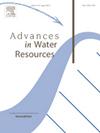图论在多空间尺度上预测岩石流体流动的性能评价
IF 4.2
2区 环境科学与生态学
Q1 WATER RESOURCES
引用次数: 0
摘要
流体在岩石中倾向于沿优先流动路径运移,这取决于亚达西尺度下的孔隙大小分布以及达西尺度下流体的非均质性和岩石物性等因素。通常,流体在岩石中的跨尺度运移是通过数值模拟来确定的,这在计算上是昂贵的。本研究提出了一种基于图论的简化物理方法来确定孔隙和连续尺度域中潜在的流体流动路径。这是对现有的基于图论的方法的改进,图论主要集中在分析流体在岩石中流动时所面临的最小阻力。提出的方法利用岩石属性作为边权,然后使用边权来计算流体侵入域内特定节点的概率。根据孔隙尺度的全物理数值模拟结果以及孔隙、岩心和砂罐尺度的实验测量数据,验证了该算法的预测结果。用于该练习的一些数据集包括Ketton和Estaillades石灰石,以及Berea和Bentheimer砂岩。进一步,将该算法应用于澳大利亚Otway盆地Paaratte组的一套准层序-2储层模型。该应用程序旨在评估网格尺寸分辨率和岩石性质分布对CO2迁移不确定性的影响。该算法显示了计算上的优势,因为它可以在一些使用传统数值模拟通常无法实现的场景下实现模型运行。本文章由计算机程序翻译,如有差异,请以英文原文为准。
Performance assessment of graph theory towards predicting fluid flow in rocks across multiple spatial scales
Fluids tend to migrate along preferential flow paths in rocks which depend on several factors including pore size distribution at sub-Darcy scales and heterogeneity in flow and petrophysical properties in Darcy scale domains. Typically, fluid migration in rocks across scales is determined using numerical simulations which can be computationally expensive. This study presents a graph theory based reduced physics approach to determine potential fluid flow pathways in pore and continuum scale domains. This is an improvement over the existing methods based on graph theory which have largely been focussed on the analysis of the minimum resistance faced by fluid when flowing in rocks. The presented method utilises rock properties as edge weights which are then used to calculate the probability of fluid invading a particular node in the domain. Predictions from the algorithm were validated against results from full physics numerical simulations at pore scale as well as experimentally measured data at pore, core and sand-tank scales. Some of the datasets used for this exercise include Ketton and Estaillades Limestones, and Berea and Bentheimer Sandstones. Further, the algorithm was applied on a suite of reservoir models of the Parasequence-2 of the Paaratte Formation, Otway Basin, Australia. This application was aimed at assessing the influence of grid size resolution and rock property distribution on the uncertainty in CO2 migration. The algorithm showed computational advantages as it was possible to achieve model runs on some scenarios which are typically not possible using conventional numerical simulations.
求助全文
通过发布文献求助,成功后即可免费获取论文全文。
去求助
来源期刊

Advances in Water Resources
环境科学-水资源
CiteScore
9.40
自引率
6.40%
发文量
171
审稿时长
36 days
期刊介绍:
Advances in Water Resources provides a forum for the presentation of fundamental scientific advances in the understanding of water resources systems. The scope of Advances in Water Resources includes any combination of theoretical, computational, and experimental approaches used to advance fundamental understanding of surface or subsurface water resources systems or the interaction of these systems with the atmosphere, geosphere, biosphere, and human societies. Manuscripts involving case studies that do not attempt to reach broader conclusions, research on engineering design, applied hydraulics, or water quality and treatment, as well as applications of existing knowledge that do not advance fundamental understanding of hydrological processes, are not appropriate for Advances in Water Resources.
Examples of appropriate topical areas that will be considered include the following:
• Surface and subsurface hydrology
• Hydrometeorology
• Environmental fluid dynamics
• Ecohydrology and ecohydrodynamics
• Multiphase transport phenomena in porous media
• Fluid flow and species transport and reaction processes
 求助内容:
求助内容: 应助结果提醒方式:
应助结果提醒方式:


